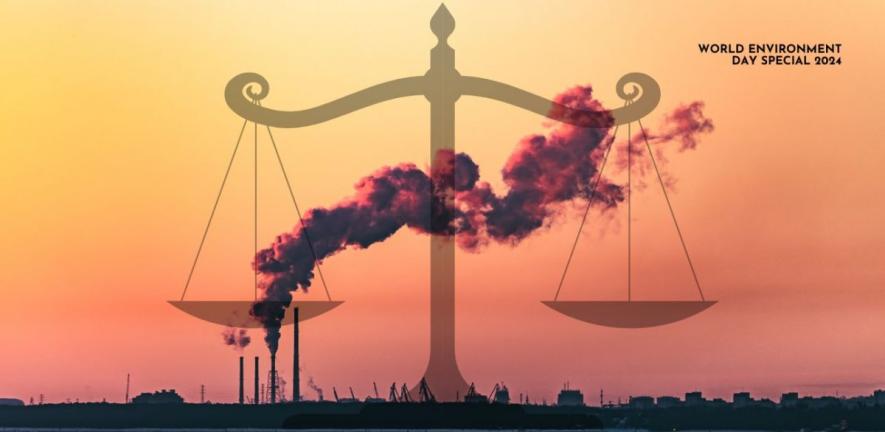Forests, Bastis and Environmental Justice in India

Image Credit: The Leaflet
On June 7, 2021, in the middle of the pandemic, Supreme Court Justices A.M. Khanwilkar and Dinesh Maheshwari refused to stop the eviction of residents of Khori Gaon from their homes by declaring that forest land is more important than the housing rights of basti dwellers. They did not think ensuring the residents were rehabilitated or provided temporary shelter before the eviction was essential.
“As far as forests are concerned, there can be no question of compromise. This is irrespective of policy and as to whether the State wants to accommodate the residents or not is up to them… This forest land has to be cleared. We do not want these Covid excuses. We cannot give any concession for forest land. We want a compliance report to be filed in four weeks. Seems like a complete case of hand-in-glove situation.” (Courtroom exchange)
These observations made by the judges were even more insensitive given that June 2021 was one of the worst months for Covid-related deaths. Khori Gaon was home to around one lakh working-class residents, mostly belonging to marginalised castes and religious minorities. Covid already had a devastating impact on the community, claiming many lives and leaving numerous families without their sole earning members.
There were multiple hearings between June and July where Khori Gaon’s lawyers pleaded for mercy on humanitarian grounds. The Bench could have halted the eviction; instead, they gave a deadline for finishing the ‘task’.
Let them eat cake
This apathy for the urban poor was also seen in Okhla Factory Owners’ Association versus The Govt. of National Capital Territory of Delhi. In the High Court of Delhi, the judges refused to listen to the residents of Yamuna Pushta who were drastically affected by the eviction Order. They did not consider the consequences for the vulnerable community losing their homes. The judges followed a familiar pattern, where they blamed the basti dwellers for the pollution of Yamuna.
Justice Sanjay Kishan Kaul declared that: “No alternative sites are to be provided in future for removal of persons who are squatting on public land… Encroachers and squatters on public land should be removed expeditiously without any prerequisite requirement of providing them alternative sites before such encroachment is removed or cleared.”
Activists and non-governmental organisations (NGOs) estimated that approximately three lakh residents were displaced from the Yamuna river bank between 2004 and 2008. Basti demolitions still continue to happen there. Similarly, just after Khori Gaon’s demolition, multiple bastis located at the foothills of the Aravallis range were slapped with eviction notices, and many were demolished.
Weaponising environmental discourse against the poor
According to the report released by advocacy group Housing and Land Rights Network (HLRN) in 2023, 49 percent of all demolitions in India in 2020 were linked to environmental projects, forest protection and wildlife conservation. This increased to 57 percent in 2022. As urban areas continue to expand, these figures are likely to rise unless there is a comprehensive reform of the judicial system.
We have reached a stage in environmental jurisprudence where demolition, often accompanied by violence, has become the norm in basti-related matters. The tool of Public Interest Litigation (PIL) has been increasingly appropriated by environmentalists to pressure the courts to issue Orders for ‘slum clearance’. Case outcomes now largely depend on the specific judge or Bench presiding over the matter.
This has eroded trust in the courts to deliver justice in basti-related matters and discouraged many community groups and activists from filing cases in the Supreme Court. We know that displacements exacerbate social inequalities and disproportionately affect vulnerable communities. Despite this, our justice system continues to think that demolition and eviction are viable options for the protection of the environment. Why?
Part of the answer lies in Justice A.M. Khanwilkar’s declaration during the court proceedings on March 29, 2022: “Environment is more important than your civil rights. Your civil rights are subordinate to the environment. Once a forest, it is always a forest unless it is denotified… Forest is not defined. So it has to be understood in common parlance— that this area has been understood as forest area and it has to be so preserved for all times to come… The public trust principle! It is only because of such strict interpretation and exposition by this court that the forest cover is increasing.”
The coming of bourgeois environmentalists
Historically, there is precedence for this kind of an approach. Conservationists have long prioritised nature over human needs. Often, this followed the colonial processes of criminalising communities who lived in these ecologically sensitive zones by terming them encroachers or squatters.
However, over time, it became evident that conservation-led evictions heighten existing inequalities, leading to livelihood loss, generational poverty and unequal citizenship. In most cases, evictees were not compensated, further entrenching their marginalisation. Hence, many conservationists objected to displacements of the marginalised and vulnerable over humanitarian and ethical grounds.
However, another group, identified by Dr Amita Baviskar as ‘bourgeois environmentalists’, started subordinating human rights to environmental concerns. This group includes the middle class and elite, who are more concerned with aesthetics than ecological sustainability, and are comfortable displacing the urban poor in the ‘public interest’. Many in the legal profession fall in this category.
One can argue that the harsh judgments delivered by many judges were driven by growing concerns over climate change, depleting forests and increasing pollution in our water bodies. The prevailing perception is that stringent actions are justified to preserve natural resources, safeguard biodiversity and combat climate change.
These perspectives frequently overlook the social and human costs of such measures. Bourgeois environmentalists assume a moral high ground over others because they believe they are the heroes fighting the good fight to save nature and the planet. However, their disdain towards bastis is not based on scientific evidence. Rather, it is a result of their deeply rooted prejudices.
They ignore the fact that these communities have very low carbon footprints and often employ more sustainable practices than their more affluent neighbours. Instead of giving credit where it is due, bourgeois environmentalists focus on appearances, giving up actual environmental sustainability for a world-class city image.
Old biases die hard
In the case of Yamuna Pushta, chemical engineer Dunu Roy estimated in his report for Hazard Centre that bastis cumulatively contributed only 0.08 percent of the discharge of polluted water into the Yamuna. The remaining 99.2 percent originated from developments considered sanitised and those that fit the world-class city narrative, that is middle-class residential colonies, the Akshardham temple and Metro headquarters.
This blatant refusal to look at evidence or conduct an investigation of the charges against basti dwellers was also seen in the Khori Gaon case. The land on which Khori Gaon stood had been subjected to extensive mining since the 1950s, which only ceased in 2009 due to a Supreme Court Order. This mining activity caused significant degradation of the landscape and deforestation.
Despite this history, Khori Gaon residents were wrongfully accused of being forest encroachers. Moreover, the land occupied by Khori Gaon residents constituted only 6.8 percent of the 1,426.4 acres in Faridabad identified by the forest department as encroached forest land. The remaining was occupied by farmhouses, hotels and various private and public institutions. Yet, the final court Order gave the privileged group the opportunity to legalise their violations, which was not given to basti dwellers.
In both the cases of Yamuna Pushta and Khori Gaon, the petitioners were criminalised even before the case started because they were basti dwellers. Historically, bastis have been equated with squalor, pollution and crime. This prejudice persists till today and leads to miscarriages of justice in court, which is supposed to be impartial.
The non-polluter pays principle
The irony is that the group least responsible for environmental degradation is the one being punished. Environmental discourses and urban planning practices have often framed bastis as polluters and squatters rather than as integral neighbourhoods of the city. Despite the urban poor being essential to the functioning of the city, the privileged groups are unwilling to share space with them, even as they rely on their labour.
What is particularly alarming is the moral bankruptcy of the judges and those cheering the eviction Orders targeting the most vulnerable groups in the name of protecting the forest or environment. This is especially egregious given the fact that the privileged groups are the primary contributors to ecological harm.
While some exemplary court Orders have recognised and supported the housing rights of basti dwellers, they remain exceptions rather than the norm. Time and again, the courts have taken punitive measures against the urban poor but spared the privileged groups from similar punishments.
This is a stark reminder that capitalism and urban planning intersect with ecological discourse to reinforce structural inequalities and injustice. Multiple studies have revealed that affluent groups have disproportionately contributed to the environmental and climate crisis through their consumption patterns, which are in contrast to the minimal impact of poorer populations.
Despite their significant contribution to ecological harm, the privileged group dictates who should bear the burden of environmental conservation. Policies and decisions are made by those in power, ignoring the fact that the urban poor are the most affected by climate change.
In order to address these injustices, it is crucial to shift the focus of environmental jurisprudence from getting rid of bastis to holding the primary contributors of ecological harm accountable. Here, the concept of ecological debt is useful.
As you sow, so shall you reap
Emerging from the social movements in the 1990s, the concept of ecological debt draws attention to the damage done by the Global North to Global South countries through resource exploitation, habitat degradation, pollution and so on. The moving force behind this concept is the idea that instead of now forcing Global South countries to deal with this damage that they did not even cause, the Global North should take responsibility for their actions and pay back their debt.
In the Indian context, the ideas of ‘forest conservation’ and ‘environmental crisis’ have been appropriated by affluent groups to demand heavy sacrifices from the most marginalised, while the former continue leading their affluent lifestyles. To find an equitable and sustainable solution for the ecological crisis, this group should confront their complicity in creating both the climate emergency and the housing inequality.
Forced evictions push communities into a cycle of poverty, exacerbating their socio-economic vulnerabilities. Given the severe lack of affordable housing, such actions will only intensify the housing crisis. Basti demolitions cannot be an answer to the complex challenges of environmental conservation and urban development. Bourgeois environmentalists must accept their role in contributing to the climate crisis and push for policies that hold those with a greater carbon footprint accountable.
Finally, the legal profession should embrace decolonial perspectives. Decolonial thought in law demands difficult conversations regarding the law’s role in oppression, human rights violations, exploitation of labour and environmental degradation. Justice cannot be achieved without accepting that legal systems and court rulings have often played a role in perpetuating injustice against basti dwellers.
The judiciary must confront its own biases and understand the historical context that has led to the unjust treatment of basti dwellers. Instead of holding environmental trials where vulnerable populations are asked to make unequal sacrifices, the relatively more privileged should be directed to bear the burden of conservation efforts.
Ishita Chatterjee is an architect who teaches at the Jindal School of Art and Architecture. Her work focuses on housing justice, informal urbanism, and architectural pedagogy.
.
Get the latest reports & analysis with people's perspective on Protests, movements & deep analytical videos, discussions of the current affairs in your Telegram app. Subscribe to NewsClick's Telegram channel & get Real-Time updates on stories, as they get published on our website.
























